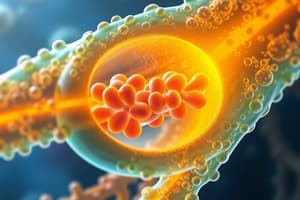Podcast
Questions and Answers
Which of the following is NOT an example of a P-class pump?
Which of the following is NOT an example of a P-class pump?
- H+/K+-ATPase
- Ca2+-ATPase
- F-class proton pumps (correct)
- Na+/K+-ATPase
What is the primary function of V-class proton pumps?
What is the primary function of V-class proton pumps?
- Maintaining an acidic environment within lysosomes (correct)
- Transporting sodium and potassium ions across the membrane
- Generating ATP from the movement of protons
- Moving protons across the mitochondrial membrane
How do P-class pumps utilize ATP to transport ions?
How do P-class pumps utilize ATP to transport ions?
- ATP is used to create a concentration gradient, which then drives the ion movement
- ATP directly binds to the ion and provides energy for transport
- ATP is converted into GTP, which then powers the ion transport
- ATP is hydrolyzed to ADP and phosphate, and the phosphate group is used to phosphorylate the pump protein (correct)
Which of the following statements correctly describes the relationship between V-class and F-class proton pumps?
Which of the following statements correctly describes the relationship between V-class and F-class proton pumps?
Which of the following is NOT a characteristic of P-class pumps?
Which of the following is NOT a characteristic of P-class pumps?
What characterizes facilitated transport in membrane transport?
What characterizes facilitated transport in membrane transport?
Which type of transporter is responsible for moving glucose into the cell?
Which type of transporter is responsible for moving glucose into the cell?
What is the main purpose of GLUT proteins?
What is the main purpose of GLUT proteins?
Which statement regarding active transport is accurate?
Which statement regarding active transport is accurate?
Co-transport involves which of the following?
Co-transport involves which of the following?
What factors affect transporter saturation during the transport of molecules?
What factors affect transporter saturation during the transport of molecules?
How many different isoforms of GLUT proteins exist?
How many different isoforms of GLUT proteins exist?
What is the primary function of glucose transporters in eukaryotic cells?
What is the primary function of glucose transporters in eukaryotic cells?
What role does GLUT-4 play in glucose transport?
What role does GLUT-4 play in glucose transport?
What transport mechanism is utilized by sodium-coupled glucose transporters?
What transport mechanism is utilized by sodium-coupled glucose transporters?
How is osmolarity defined?
How is osmolarity defined?
What happens to a cell placed in a dilute solution?
What happens to a cell placed in a dilute solution?
What is the osmolarity of a 150 mM NaCl solution?
What is the osmolarity of a 150 mM NaCl solution?
Which statement about aquaporins is true?
Which statement about aquaporins is true?
Which of the following best describes ATP-powered pumps?
Which of the following best describes ATP-powered pumps?
Which type of transport is not involved in the function of glucose transporters?
Which type of transport is not involved in the function of glucose transporters?
Flashcards
Protein-mediated transport
Protein-mediated transport
Movement of molecules across a membrane with the help of transport proteins.
Facilitated Transport
Facilitated Transport
Moving molecules down their concentration gradient using transport proteins. This movement can be facilitated by uniporters or ion channels.
Active Transport
Active Transport
Movement of molecules against their concentration gradient using energy from ATP. ATP-powered pumps are responsible.
Co-transport
Co-transport
Signup and view all the flashcards
Saturation of Transporters
Saturation of Transporters
Signup and view all the flashcards
GLUT proteins
GLUT proteins
Signup and view all the flashcards
Glucose-6-phosphate conversion
Glucose-6-phosphate conversion
Signup and view all the flashcards
GLUT protein isoforms
GLUT protein isoforms
Signup and view all the flashcards
Insulin-stimulated glucose uptake
Insulin-stimulated glucose uptake
Signup and view all the flashcards
Sodium-coupled glucose transporter
Sodium-coupled glucose transporter
Signup and view all the flashcards
Symporter
Symporter
Signup and view all the flashcards
Secondary active transport
Secondary active transport
Signup and view all the flashcards
Osmolarity
Osmolarity
Signup and view all the flashcards
Aquaporin
Aquaporin
Signup and view all the flashcards
ATP-powered Pumps
ATP-powered Pumps
Signup and view all the flashcards
ATP-powered Pumps: Function
ATP-powered Pumps: Function
Signup and view all the flashcards
What are P-class pumps?
What are P-class pumps?
Signup and view all the flashcards
What does Na+/K+-ATPase do?
What does Na+/K+-ATPase do?
Signup and view all the flashcards
What are Ca2+-ATPases?
What are Ca2+-ATPases?
Signup and view all the flashcards
What are V-class proton pumps?
What are V-class proton pumps?
Signup and view all the flashcards
What are F-class proton pumps?
What are F-class proton pumps?
Signup and view all the flashcards
Study Notes
Membrane Transport
- Membrane transport encompasses various mechanisms enabling substances to move across cellular membranes.
- Integral membrane proteins are crucial for this process, with different types like single-pass, multipass, and multi-subunit proteins.
- Peripheral membrane proteins are also involved, as well as lipid-anchored membrane proteins, utilizing fatty acids or isoprenyl anchors.
Membrane Transporters: Doorways to the Cell
- Passive transport involves channel-mediated and carrier-mediated processes, moving molecules down their concentration gradients.
- Simple diffusion represents a passive method of movement.
- Active transport necessitates energy to move molecules against their concentration gradients.
Protein-mediated Transport
- ATP-powered pumps, ion channels, and transporters are key protein-mediated transport mechanisms.
- ATP-powered pumps utilize ATP's energy to move substances, operating at rates ranging from 100 to 103 ions/sec for pumps to 102 to 104 molecules/sec for transporters and 107–108 ions/sec for channel proteins.
- Uniporters transport a single type of molecule.
- Symporters transport two types of molecules in the same direction.
- Antiporters transport two types of molecules in opposite directions.
- Ion channels facilitate the movement of ions.
Facilitated Transport
- Facilitated transport moves molecules down their concentration gradient with the help of integral proteins.
Active Transport
- Active transport moves molecules against their concentration gradient, requiring energy input.
Co-transport
- Co-transport is a form of active transport involving the movement of one molecule against its concentration gradient, coupled to the movement of another molecule down its concentration gradient. This process is mediated by symporters and antiporters.
Membrane Transporters
- Transporters can exhibit saturation when the concentration of the transported molecule is high, as the rate of transport increases with increasing substrate concentration, reaching a plateau when all transporter proteins are occupied.
Glucose Transporters
- Glucose is a vital energy source for eukaryotic organisms, predominantly utilized intracellularly.
- Glucose transport across membranes is essential.
- GLUT proteins (e.g., GLUT4) mediate glucose transport down its concentration gradient, enabling efficient uptake into cells.
- Sodium-coupled glucose transporters (SGLTs) move glucose against its concentration gradient, utilizing the sodium gradient as an energy source.
- In cells, glucose is rapidly converted to glucose-6-phosphate to maintain a low intracellular glucose concentration, favoring its continued uptake.
Water Transport
- Water, like ions, spontaneously moves across a membrane down its concentration gradient.
- Osmolarity denotes the number of solute particles per unit volume (Osm/L), contrasting with concentration (mol/L), which merely measures the number of molecules.
- Water movement impacts cell size: cells swell in dilute solutions (hypotonic) and shrink in concentrated solutions (hypertonic).
- Aquaporins are specialized water channels accelerating water transport across biological membranes.
ATP-Powered Pumps
- ATP-powered pumps consume ATP energy to move molecules against their concentration gradients.
- Different pump types exist, including P-class pumps, V-class proton pumps, F-class proton pumps, and ABC transporters, each serving distinct cellular functions.
- P-class pumps, such as the Na+/K+ ATPase and Ca2+ ATPase, utilize ATP's energy for ion transport against the concentration gradient, causing conformational changes in the protein.
ABC Transporters
- ABC transporters are a diverse group of ATP-powered pumps that transport a broad range of small molecules, including certain drugs, across membranes.
Studying That Suits You
Use AI to generate personalized quizzes and flashcards to suit your learning preferences.
Related Documents
Description
Test your knowledge on the various mechanisms of membrane transport, including passive and active processes. Explore the roles of integral and peripheral membrane proteins in cellular transport. Understand how substances cross membranes through different transport mechanisms.




